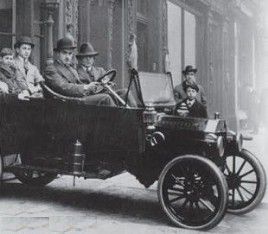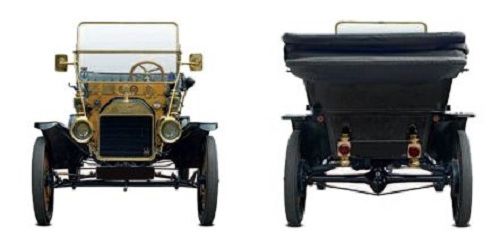The Model T led an industrial and social revolution, introducing massproduction techniques to car manufacturing and motorizing the United States. Thanks to Henry Ford’s 1913 introduction of a moving assembly line, production hit 1,000 per day in 1914, and U.S. output peaked in 1923, when two million “Tin Lizzies” were made. More than 15 million Model Ts were made from 1908 until 1927, a record-breaking figure that was overtaken only by Volkswagen’s Beetle in 1972. The Model T introduced several innovations to car manufacturing.

- Assembly Detroit, USA, and worldwide
- Production 15,007,003
- Construction Separate chassis, steel body
- Engine 2,896 cc, straight-four
- Power output 20-22 hp at 1,800 rpm
- Transmission Two-speed epicyclic
- Suspension Rigid axles;transverse leaf springs
- Brakes Drum rear and drum on transmission
- Maximum speed 40-45 mph (64-72 km/h)
It had a monobloc engine, and the transmission was directly attached to the power unit. With an unusual epicyclic (or “planetary”) transmission, it also offered near-automatic driving with no clashing of gears. Affectionately called the “Tin Lizzie,” the car was known for its extreme robustness. Its ruggedness was due to Henry Ford’s insistence on using strong materials; he pioneered the use of light-but-tough vanadium steel.

Costs were controlled by keeping the specifications simple and squeezing dealer margins. From 1914 to 1926, black was the only color offered-black enamel dried more quickly, enabling production-line speeds to be sustained. As sales went up, ever-increasing numbers of the Model T were made at ever-decreasing prices. Reliable and affordable, by 1918 the Model T accounted for half of all cars in the United States.

Built for American roads With high ground clearance and simple transverse-leaf suspension, the Model T was tailor-made for the poor quality, often unsurfaced, U.S. roads of the time. The absence of front brakes and of any dampers might be regarded as faults, but the engine’s easy pulling power and the need for minimal gearchanging were virtues, as was its 25-30 mpg (11-13 km/l) fuel consumption.
The iconic Ford script was created by Childe Harold Wills-Henry Ford’s chief engineering assistant-in 1903. Wills had trained as a commercial artist, and the script was based on one he had previously used on visiting cards. “The script is still in use today.”

Running changes
The basics of the engine stayed the same throughout its lifetime, once the water pump of early models had been replaced by the Thermo Syphon system. Some adjustments were made to the compression ratio to account for changeable fuel quality. It peaked at 4.5:1, before being pegged at 3.98:1 from 1917.
Uphill, Model T style
In the drive for simplicity, Henry Ford built the Model T without a fuel pump, relying instead on gravity to feed fuel to the carburetor. One consequence of this was that when the fuel level in the tank was low, it was sometimes necessary to reverse the car up hills.
Ford Model T straight-four
Henry Ford’s iconic Model T-the car that would turn millions of Americans into drivers following its launch in 1908-was remarkable for more than the efficient production-line methods used to build it. The “Tin Lizzie,” as it became known, also boasted many novel engineering features, particularly in the design of its simple but rugged engine and transmission.
Ford Model T exterior
- 1. “Ford” script
- 2. Boyce Motometer water-temperature gauge on top of radiator grille
- 3. Acetylene-powered headlamps
- 4. Starting handle needed to be cranked to get the Model T going
- 5. Additional lights mounted on the scuttle
- 6. Cogged drive on wheel hub operates speedometer
- 7. Wooden artillery wheels standard until 1926
- 8. Elaborate, scuttle-mounted bulb horn
- 9. Brass door handle
- 10. Cylinder stores acetylene to power lights
- 11. Branded footplate on running board
- 12. Tail and side lights are kerosene-powered
The Model T underwent three fundamental styling changes. The brass radiator shell, as on this 1911 model, was replaced in 1917 with a painted shell, and the mudguards became domed rather than flat. Then in 1923 a revised, more curvaceous hood-line gave the car a modern look. Finally, in 1926 the chassis height was reduced and new lower bodies brought in, with the option of wire wheels.
Ford Model T interior
- 13. Dashboard partly shields occupants from splashes of rain or road dirt
- 14. 0-50 mph speedometer reflects modest performance
- 15. Eccentric pedal layou
- 16.Spare wheel behind driver’s seat
- 17. Buttoned leather upholstery
- 18. Brass “threshold” plate
The “T” has the simplest of interiors, but an odd pedal layout. Pressing the left-hand pedal fully engages first gear, releasing it halfway selects neutral, and fully releasing it gives top gear. The center pedal operates reverse, the right-hand pedal works the transmission brake. The hand lever works the rear-wheel brakes.
Under the hood Ford Model T
- 19. Trembler coils for ignition housed in box on dashboard
- 20. Transmission housing under the floor
- 21. Hood clip
- 22. Hood handle
- 23. Four-cylinder engine has a capacity of nearly 3 liters
The 2,896 cc, side-valve, four-cylinder engine of the “T” was advanced in its day. It has four cylinders cast as one block. Lubricating oil is propelled around the engine by gravity rather than being circulated by a pump. The pistons are cast-iron. With small valves and a very low compression ratio, output is only 20-22 bhp, and maximum crankshaft speed a mere 1,800 rpm.